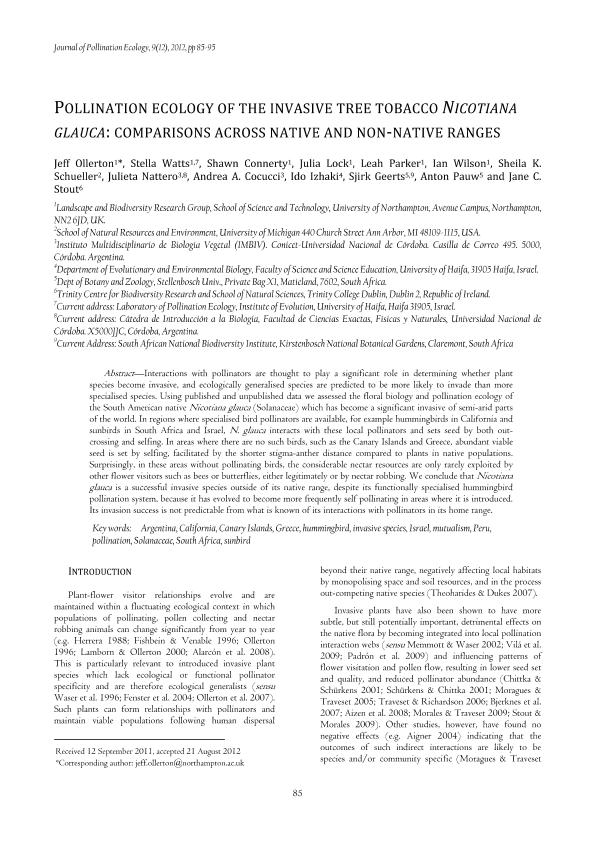Mostrar el registro sencillo del ítem
dc.contributor.author
Ollerton, Jeff
dc.contributor.author
Watts, Stella
dc.contributor.author
Connerty, Shawn
dc.contributor.author
Lock, Julia
dc.contributor.author
Parker, Leah
dc.contributor.author
Wilson, Ian
dc.contributor.author
Schueller, Sheila K.
dc.contributor.author
Nattero, Julieta

dc.contributor.author
Cocucci, Andrea Aristides

dc.contributor.author
Izhaki, Ido
dc.contributor.author
Geerts, Sirjk
dc.contributor.author
Pauw, Anton
dc.contributor.author
Stout, Jane C.
dc.date.available
2017-06-22T18:09:35Z
dc.date.issued
2012-09
dc.identifier.citation
Ollerton, Jeff; Watts, Stella; Connerty, Shawn; Lock, Julia; Parker, Leah; et al.; Pollination ecology of the invasive tree tobacco nicotiana glauca: comparisons across native and non-native ranges; Public Knowledge Project; Journal of Pollination Ecology; 9; 12; 9-2012; 85-95
dc.identifier.issn
1920-7603
dc.identifier.uri
http://hdl.handle.net/11336/18661
dc.description.abstract
Interactions with pollinators are thought to play a significant role in determining whether plant species become invasive, and ecologically generalised species are predicted to be more likely to invade than more specialised species. Using published and unpublished data we assessed the floral biology and pollination ecology of the South American native Nicotiana glauca (Solanaceae) which has become a significant invasive of semi-arid parts of the world. In regions where specialised bird pollinators are available, for example hummingbirds in California and sunbirds in South Africa and Israel, N. glauca interacts with these local pollinators and sets seed by both outcrossing and selfing. In areas where there are no such birds, such as the Canary Islands and Greece, abundant viable seed is set by selfing, facilitated by the shorter stigma-anther distance compared to plants in native populations. Surprisingly, in these areas without pollinating birds, the considerable nectar resources are only rarely exploited by other flower visitors such as bees or butterflies, either legitimately or by nectar robbing. We conclude that Nicotiana glauca is a successful invasive species outside of its native range, despite its functionally specialised hummingbird pollination system, because it has evolved to become more frequently self pollinating in areas where it is introduced. Its invasion success is not predictable from what is known of its interactions with pollinators in its home range.
dc.format
application/pdf
dc.language.iso
eng
dc.publisher
Public Knowledge Project
dc.rights
info:eu-repo/semantics/openAccess
dc.rights.uri
https://creativecommons.org/licenses/by/2.5/ar/
dc.subject
Invasion
dc.subject
Tobacco
dc.subject
Nicotiana
dc.subject
Pollination
dc.subject.classification
Ecología

dc.subject.classification
Ciencias Biológicas

dc.subject.classification
CIENCIAS NATURALES Y EXACTAS

dc.title
Pollination ecology of the invasive tree tobacco nicotiana glauca: comparisons across native and non-native ranges
dc.type
info:eu-repo/semantics/article
dc.type
info:ar-repo/semantics/artículo
dc.type
info:eu-repo/semantics/publishedVersion
dc.date.updated
2017-06-16T21:30:24Z
dc.journal.volume
9
dc.journal.number
12
dc.journal.pagination
85-95
dc.journal.pais
Países Bajos

dc.description.fil
Fil: Ollerton, Jeff. University of Northampton. School of Science and Technology. Landscape and Biodiversity Research Group; Reino Unido
dc.description.fil
Fil: Watts, Stella. University of Northampton. School of Science and Technology. Landscape and Biodiversity Research Group; Reino Unido
dc.description.fil
Fil: Connerty, Shawn. University of Northampton. School of Science and Technology. Landscape and Biodiversity Research Group; Reino Unido
dc.description.fil
Fil: Lock, Julia. University of Northampton. School of Science and Technology. Landscape and Biodiversity Research Group; Reino Unido
dc.description.fil
Fil: Parker, Leah. University of Northampton. School of Science and Technology. Landscape and Biodiversity Research Group; Reino Unido
dc.description.fil
Fil: Wilson, Ian. University of Northampton. School of Science and Technology. Landscape and Biodiversity Research Group; Reino Unido
dc.description.fil
Fil: Schueller, Sheila K.. University of Michigan. School of Natural Resources and Environment; Estados Unidos
dc.description.fil
Fil: Nattero, Julieta. Consejo Nacional de Investigaciones Científicas y Técnicas. Centro Científico Tecnológico Conicet - Córdoba. Instituto Multidisciplinario de Biología Vegetal. Universidad Nacional de Córdoba. Facultad de Ciencias Exactas Físicas y Naturales. Instituto Multidisciplinario de Biología Vegetal; Argentina
dc.description.fil
Fil: Cocucci, Andrea Aristides. Consejo Nacional de Investigaciones Científicas y Técnicas. Centro Científico Tecnológico Conicet - Córdoba. Instituto Multidisciplinario de Biología Vegetal. Universidad Nacional de Córdoba. Facultad de Ciencias Exactas Físicas y Naturales. Instituto Multidisciplinario de Biología Vegetal; Argentina
dc.description.fil
Fil: Izhaki, Ido. University of Haifa. Faculty of Science and Science Education. Department of Evolutionary and Environmental Biology; Israel
dc.description.fil
Fil: Geerts, Sirjk. Stellenbosch University. Department of Botany and Zoology; Sudáfrica
dc.description.fil
Fil: Pauw, Anton. Stellenbosch University. Department of Botany and Zoology; Sudáfrica
dc.description.fil
Fil: Stout, Jane C.. Trinity College Dublin. Trinity Centre for Biodiversity Research and School of Natural Sciences, Trinity College Dublin; Reino Unido
dc.journal.title
Journal of Pollination Ecology
dc.relation.alternativeid
info:eu-repo/semantics/altIdentifier/url/http://www.pollinationecology.org/index.php?journal=jpe&page=article&op=view&path%5B%5D=189
Archivos asociados
